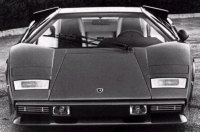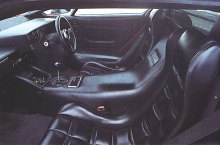5000QV - by Fast Lane magazine
In the September 1986 issue of Fast Lane magazine, editor Peter Dron tested a Countach 5000QV in Italy. The car was owned by ex-F1 driver Pierluigi Martini, with fairly well run-in because he usually drove it to 320 kph (199mph) according to the slightly optimistic speedometer. The following is the summary of that report: Lamborhgini
sells Countaches at a special discount to Grand Prix drivers, and that's
one reason why Pierluigi Martini has one. Keke Rosberg's pearl white car
with big tail wing is at the factory for a service. Martini's car does
not have the wing : neither he nor Lamborghini approves of it.
Lamborhgini
sells Countaches at a special discount to Grand Prix drivers, and that's
one reason why Pierluigi Martini has one. Keke Rosberg's pearl white car
with big tail wing is at the factory for a service. Martini's car does
not have the wing : neither he nor Lamborghini approves of it.
Firing up the Countach from cold calls for a sequence of actions which almost form a ritual. Switch on the ignition and wait for the ticking of the fuel pumps to fade away. Turn the key further and you will know that the engine has started even if you are deaf, from all the opening windows and the birds flying from the trees. That ferocious, hungry growl, which you get only with multiple carburetters on a multi-cylinder engine settles into a deep rumble. It is necessary to wait a little longer for the various fluids to flow properly, particularly in the gearbox, which initially feels as if it has seized.
Drivetrain
... very positive gearchange and even if the movements through the slotted gate are rather long, it's really a question of how quickly you can move your hand. The Fichtel and Sachs clutch is very heavy, and being stuck in West End traffic in a Countach late on a Friday afternoon must be an excellent exercise for building up the thigh muscles ... this is something that you simply have to put up with, but we did wonder about the unusual amount of force required of one's right foot in initially depressing the throttle. It feels as if one is on the wrong end of an over-centre situation, to coin a phrase. After that, throttle response is miraculously smooth, every tiny movement eliciting a small answer from the engine, which is what is needed in a car like this.Although maximum torque seems high up the range at 5,200 rpm, our acceleration figures in top and fourth show that the curve must be a very flat one with, as we had decided subjectively, with plenty from 3,000 rpm onwards, which means that this engine has an unusually wide useable rev band, even for a big V12. Indeed, the response to flooring the throttle at only 1,500rpm in top (about 36mph) is simply instant, smooth, turbine-like acceleration, and the figures from 40mph onwards are outstanding.
... The ratios are well spaced that pushing the throttle to the floor in any gear at almost any speed produces the sort of acceleration that really does force your neck backwards.
If nobody told you that the brakes were servo-assisted, you'd probably not suspect it: here's another useful muscle-toning device ...
Handling
As with the rest of the car, it's not just what the brakes do, but the way that they do it that impresses. Repeated, punishing decelerations from extreme speeds failed to melt the pads or boil the fluid. The was no signs of fade, no tugging from side to side, no premature locking ... You
then arrive at your first bend in the Countach, and its response to your
actions are so precise, and predictable, that you instantly feel that the
car is working for you, whereas in some rivals you feel that you are sitting
on the back of a wild animal, trying desperately to maintain the illusion
of control.
You
then arrive at your first bend in the Countach, and its response to your
actions are so precise, and predictable, that you instantly feel that the
car is working for you, whereas in some rivals you feel that you are sitting
on the back of a wild animal, trying desperately to maintain the illusion
of control.
The first surprise is that the unassisted steering, rack and pinion, naturally, is light in the straight ahead position even at very low speeds.... Turn into a bend, the weight (steering) builds up. Always you can feel very easily where the front wheels are pointing, and usually only a small amount of lock is required. It is unnecessary to fight the steering.
With an overall rubber contact patch unequalled by any other road car (the rear tyres are 345/35VR15 on 12in rims, and the fronts are 225/50VR15 on 8.5in rims), it is hardly surprising that dry road grip is outstanding. But roadholding is one thing and overall handling another, and the more impressive aspects of Countach are how well balanced it feels, how much true feel of the surface is fed to the driver via the wheel and through the chassis, and how progressively and predictably it responds to suggestions that it should change direction. Again, it is working with the driver rather than against him.
No doubt a Porsche 959 would leave a Countach floundering on a twisty route in poor conditions, but that would not be so in the dry. The combination of more than 450 horsepower and race-car-sized tyres demands a certain level of skill, but that admitted, there are many cars with engines of lower output which are more difficult to drive. (Note: say, a Porsche 911 Turbo)
In a tight bend, it is possible to punch the tail out with a brutal and sustained stamp on the throttle pedal. It isn't really necessary to indulge in such hooliganism, and the joy of Countach is the way it can be made to flow through a series of curves, with scarcely any perceptible roll.
Interior
 Getting
in and out of the Countach requires a special technique. You pull the catch,
and the door swings forwards and upwards to an angle of 45 degrees. Then
you sit on the very wide sill, in the gap formed by door, roof and door
jamb. It is not a big gap. After that, there are two alternative methods
of gaining entry. The first is to ease your body in first, dragging your
legs through under the steering wheel, trying not to entangle your feet
in the pedals, and then to squeeze through after them. It's not too difficult
once you've got the hang of it.
Getting
in and out of the Countach requires a special technique. You pull the catch,
and the door swings forwards and upwards to an angle of 45 degrees. Then
you sit on the very wide sill, in the gap formed by door, roof and door
jamb. It is not a big gap. After that, there are two alternative methods
of gaining entry. The first is to ease your body in first, dragging your
legs through under the steering wheel, trying not to entangle your feet
in the pedals, and then to squeeze through after them. It's not too difficult
once you've got the hang of it.
Surprisingly, the space inside the car is not too bad, and it is considerably less cramped than an Esprit (Lotus), for example; nor does it give the same claustrophobic feeling. Even for tall drivers, there is about sufficient headroom, though it is necessary to drive with knees bent ... the trimming is competently executed, though it does not give that air of plush luxury that you find in an Aston Martin or the crisp, modern and efficient environment of the latest Ferraris.
 The
seats are of a true "bucket" design ... They offer good lateral location
and acceptably comfortable for journeys of moderate length ... The carpeted
boot, though by no means large, is not too bad for this type of car. The
front lid conceals a get-you-hom-if-you -aren't-arrested spare tyre, the
battery, the brake servo, and not much else.
The
seats are of a true "bucket" design ... They offer good lateral location
and acceptably comfortable for journeys of moderate length ... The carpeted
boot, though by no means large, is not too bad for this type of car. The
front lid conceals a get-you-hom-if-you -aren't-arrested spare tyre, the
battery, the brake servo, and not much else.
Its forward vision is acceptable when you get used to looking through that huge pane of glass set in a shallow incline: ahead of you, it is just possible to see the highest peaks of the front wheel arches, but you must guess where the nose might be. At each side, there is a pattern of four small panes of glass. One of these can be lowered - by a manual winder - and the theory is that you can use it for paying autostrada tolls.
 It
is a crazy vision made into reality. It costs a fortune. It is totally
impractical. There is no way that buying it could be justified by any rational
argument, but if you are a true car enthusiast and immensely wealthy, you
will feel obligued to ignore all those sensible, puritanical, 'realistic'
mumblings from one side of your brain, and listen to the other side shouting
'Countach!'
It
is a crazy vision made into reality. It costs a fortune. It is totally
impractical. There is no way that buying it could be justified by any rational
argument, but if you are a true car enthusiast and immensely wealthy, you
will feel obligued to ignore all those sensible, puritanical, 'realistic'
mumblings from one side of your brain, and listen to the other side shouting
'Countach!'